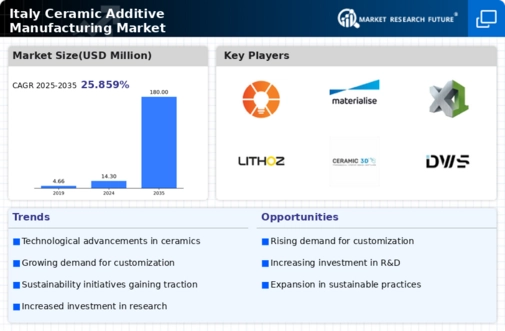The competitive landscape of the Italy Ceramic Additive Manufacturing Market is characterized by a dynamic interplay of innovation, technological advancements, and a growing demand for customized solutions in the ceramics sector. Various companies are vying for market share, driven by the increasing applications of ceramic materials across industries such as aerospace, healthcare, and automotive. This competitive arena witnesses the emergence of both established players and new entrants, all aiming to leverage cutting-edge technologies to enhance efficiency and product offerings.
The landscape reveals a mix of local and international companies that are focused on creating unique value propositions to cater to the specific needs and preferences of the Italian market. The rising awareness regarding sustainable manufacturing practices serves as a catalyst for growth, pushing companies to innovate and offer environmentally friendly solutions while maintaining the qualities essential to ceramics. Focusing specifically on EOS within the context of the Italy Ceramic Additive Manufacturing Market, the company has established a strong foothold by offering advanced solutions tailored to the needs of various industries.
Known for its expertise in additive manufacturing technology, EOS has developed reliable and high-performance systems that cater to the complex requirements of ceramic production. The strengths of EOS lie in its robust technology that allows clients to achieve high levels of precision and material compatibility, which are crucial in the ceramic sector. Their commitment to research and development facilitates continuous innovation, ensuring that they remain at the forefront of the market.
Moreover, EOS's strategic focus on customer collaboration enables the company to deliver tailored solutions, effectively addressing specific challenges in ceramic additive manufacturing, which further solidifies their market position in Italy. On the other hand, Materialise has carved its niche in the Italy Ceramic Additive Manufacturing Market by providing comprehensive services that include software solutions and additive manufacturing capabilities. The company offers a suite of key products designed to enhance the efficiency of the production process, thereby appealing to a broad spectrum of industries.
With a strong emphasis on software tools for 3D printing, Materialise empowers designers and manufacturers to optimize their ceramic applications. Their market presence in Italy is distinguished by a commitment to innovation and a broad portfolio of services that cater to the unique demands of local clients. Through strategic partnerships and potential mergers within the region, Materialise effectively enhances its capabilities and market outreach.
The strengths of Materialise lie in its ability to integrate advanced technology with user-friendly solutions, ensuring that customers can effectively harness the potential of additive manufacturing in ceramics, thereby fostering growth and expanding their influence in the market.



















